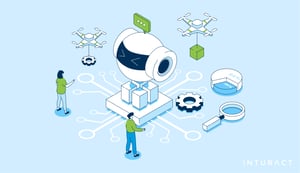In a landscape brimming with competition, delivering a stellar user experience from the get-go is not just an option; it's a necessity. Fortunately, the right set of tools can streamline this process, transforming how users perceive and interact with your software.
Today, we're delving into four user onboarding automation tools that are game-changers for any B2B SaaS company.
These platforms offer a variety of features designed to automate the onboarding process, making it seamless, personalized, and scalable. Whether you're a product manager, a founder, or a product owner, these tools are crafted to elevate your user experience without demanding a line of code from you.
What is user onboarding automation?
User onboarding automation is a systematic approach to guide new users in understanding and navigating a SaaS product, through the use of automated tools and workflows that deliver information, prompts, and support at key moments in the user's initial experience.
This process is designed to be self-service, meaning the users can get up to speed without direct human assistance, through pre-programmed instructions, tutorials, and check-ins.
The automation aspect involves setting up triggers based on user actions or timelines that will automatically send out emails, show in-app messages, offer resources, or provide assistance. This ensures that every user receives a consistent level of guidance and support, tailored to their stage in the onboarding process, without requiring manual intervention from the company's staff each time a new user signs up.
Imagine you've created a project management tool. Here's a simple automated onboarding flow:
- Account Creation: As soon as someone signs up, they are automatically sent a welcome email with their login details and a link to start their onboarding.
- Initial Login: The first time they log in, an interactive walkthrough begins. This could be a series of pop-up messages or highlight features on their screen, showing them how to create their first project, add team members, and set up tasks.
- Follow-Up: If they haven’t created a project within a day or two, an automated email is sent out encouraging them to do so, maybe with a video tutorial link.
- Check-In: After a week, your system checks if they have logged in again. If not, another automated email goes out, perhaps offering to book a demo or a call for any help they might need.
This kind of automation makes sure that new users aren't left feeling lost and helps them see the value of your product quickly, which can lead to higher satisfaction and retention rates. For you it’s an efficient way to scale your user base without multiplying your workload.
How do user onboarding tools help?
User onboarding tools are critical components of a SaaS business strategy, serving both tactical and strategic functions. These tools are designed to facilitate users’ understanding and adoption of your product, ultimately influencing their long-term success and your company's bottom line.
Tactically, user onboarding tools help in the following ways:
- Reducing Friction: They simplify the initial user experience by automating routine tasks such as account creation, data input, and basic configurations. This means new users can get to the "aha moment" quicker — the point where they understand the value of your product.
- Scalability: Automation allows you to onboard a large number of users simultaneously without a proportional increase in support or staff resources. This is especially important in a B2B context, where you might be onboarding entire teams or departments at once.
- Consistency: They ensure that every user gets the same high-quality introduction to your product, regardless of when they sign up or what their specific use case might be. This includes consistent messaging, resources, and guidance.
- Personalization: Many onboarding tools come with analytics and customization options that allow you to create a personalized onboarding flow based on user behavior, role, industry, or other factors, which can significantly increase engagement and retention.
- Feedback Collection: Integrated surveys and feedback prompts can help you gather immediate insights into user experiences, allowing for quick iterations and improvements.
- Educational Content Delivery: They can schedule and deliver educational content like tutorials, tooltips, webinars, and documentation exactly when the user is most likely to need it.
Strategically, user onboarding tools serve to:
- Drive Product Adoption: By providing a clear path to value, these tools help users integrate the product into their workflows, encouraging stickiness and increasing the likelihood of product adoption.
- Support Data-Driven Decisions: The analytics provided by onboarding tools give valuable insights into user behavior, helping to inform product development and strategic decision-making.
- Reduce Churn: Effective onboarding that quickly demonstrates value can reduce early churn, as users are less likely to give up on a product they understand and find useful.
- Enable Customer Success: By equipping users with the knowledge and skills they need to succeed with your product, you're setting the stage for customer success, which is crucial for B2B SaaS companies where long-term contracts and relationships are common.
- Optimize Resource Allocation: With automation handling routine onboarding tasks, your team can focus on higher-value interactions and support, optimizing your human resources for where they’re needed most.
- Increase Lifetime Value (LTV): A well-onboarded customer is more likely to upgrade, purchase additional services, or advocate for your product, all of which increase the customer’s lifetime value to your company.
User onboarding tools are not just about teaching someone how to use a software product; they are about creating a first experience with the product that is so impactful that it leads to higher engagement, customer satisfaction, and ultimately, revenue growth.
4 best user onboarding tools for B2B SaaS
1. UserGuiding
UserGuiding is a no-code digital adoption and user onboarding solution that enables companies to effortlessly create interactive guides for their products.
Features:
- Interactive Onboarding Guides: Create step-by-step walkthroughs to guide users through your website or application.
- Customizable Tooltips: Design and implement contextual hints and tips to help users navigate your platform.
- Segmentation and Targeting: Deliver personalized onboarding experiences by targeting specific user segments based on their behavior or attributes.
- Analytics: Track user engagement and analyze the performance of your onboarding flows to optimize the user experience.
- No-Code Integration: Easily integrate with your platform without the need for extensive coding knowledge.
2. AppCues
Appcues is a tool used for creating in-app user experiences, such as onboarding flows, announcements, and feature highlights, to improve product adoption and user retention, without the need for deep technical expertise.
- Customizable Onboarding Flows: Appcues allows you to build and customize onboarding flows that guide new users through your app, with the aim of improving time-to-value and reducing churn.
- In-App Surveys and Feedback Collection: The platform enables you to create and deploy in-app surveys and NPS scores to gather user feedback directly within the app, providing insights into user satisfaction and areas for improvement.
- Targeting and Segmentation: Appcues offers advanced targeting capabilities, enabling you to deliver personalized experiences based on user behavior, properties, and lifecycle stages to ensure the right users see the right content at the right time.
3. UserFlow
UserFlow is a tool that lets you build and integrate helpful guides and prompts inside your SaaS product without needing to write code. Think of it as a way to hand-hold new users through your app, showing them the ropes so they can get up to speed quickly and see the value in what you’ve built.
You can use UserFlow to:
- Set up onboarding checklists: You can create a list of key actions you want your new users to take. This helps them start on the right foot and ensures they don’t miss out on any important features.
- Show interactive tips: Point out new features or complex functionalities with little pop-up boxes. This makes sure users notice and understand these features, which they might otherwise overlook.
- Gather user feedback effortlessly: Drop in surveys at just the right spots within your app to ask users what they think or if they need help, giving you instant insights into their experience.
- Customize flows for different users: Not all users are the same. UserFlow allows you to tailor the onboarding experience based on who’s using the app, whether they’re beginners or power users, so it’s always relevant.
4. UserPilot
Userpilot is a tool that helps product teams at B2B SaaS companies increase user engagement through behavior-triggered in-app experiences. It enables non-technical staff to create, implement, and optimize user onboarding flows, feature adoption prompts, and feedback surveys.
With Userpilot, you can:
- Create Interactive Onboarding Flows: Design step-by-step tutorials that guide your users through your app. It's like giving each user their own personal tour guide.
- Segment Users for Personalized Experiences: Tailor the onboarding experience for different groups of users. For example, newbies get the basics while advanced users can skip straight to the expert stuff.
- Set Up Triggers Based on Behavior: Launch specific onboarding steps or messages depending on what your users do (or don’t do) in the app. If someone hasn’t used a feature yet, Userpilot can nudge them to try it.
- Collect Feedback Inside the App: Drop in microsurveys or NPS scores to ask users what they think about your app or a new feature, right where they’re using it.
- Analyze and Optimize: Get data on how your onboarding steps are performing, so you can tweak them to make sure they’re as effective as possible.
How to get the most out of any user onboarding tool you use?
In the end, user onboarding tools are just that—tools. They are incredibly useful, but they can't create a successful user onboarding experience on their own. For that, you need a solid strategy.
It's essential to understand the key moments that matter to your users, like when they first grasp the value of your product, or when they start to make it a part of their daily routine. You also need to know what kind of messages to send and when to send them to keep users engaged and moving forward.
That's where Inturact comes in.
It's a SaaS Activation & Onboarding Agency that specializes in building effective onboarding strategies for high-growth SaaS products. We don't just help you choose the right tools; we work with you to use them in the best way possible. Our services are designed to help you make the most out of your onboarding process, turning new users into loyal customers.
If you're looking to improve how new users experience your product, Inturact is here to help. We provide the expertise you need to get the results you want from your user onboarding tools and beyond. Schedule a call with us here.



